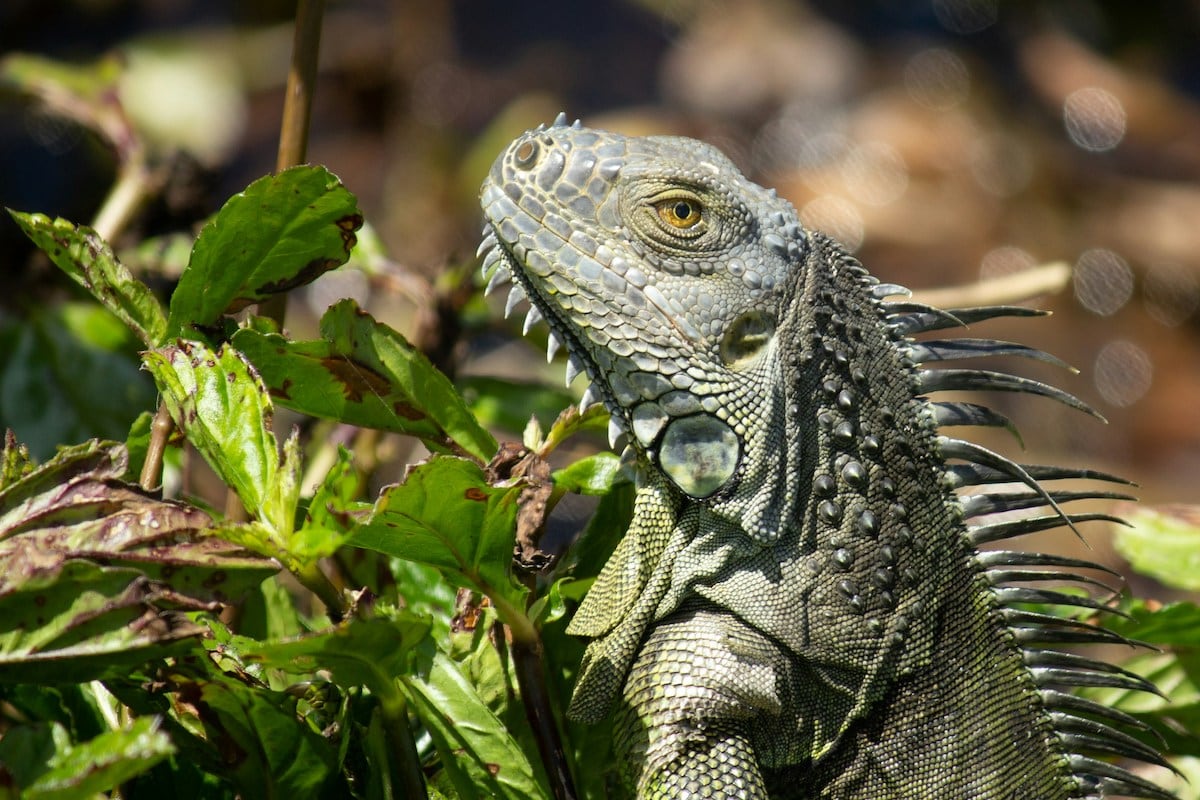Iguanas are fascinating reptiles that exhibit a variety of distinctive behaviors which often intrigue and perplex their owners. Recognizing and understanding these behaviors are crucial for those who keep these creatures as pets or simply observe them in their natural habitat. Through careful observation, you can gain valuable insights into their daily habits and tendencies, which is essential for ensuring their well-being.
Among the things you should be attentive to is their body language. Iguanas communicate a great deal through physical cues such as head bobbing, tail whipping, and dewlap display. These behaviors can signify anything from territoriality and aggression to courtship or fear. In addition to body language, an iguana’s eating patterns also provide important information about its health and mood.
Understanding how an iguana interacts with its environment is another key aspect of its behavior. They are known for their climbing ability and need for spacious environments to explore. Observing how an iguana moves within its space helps clarify its likes, dislikes, and overall comfort levels. Always keep an eye on these behaviors, as they can be indicators of an iguana’s overall health and aggression.
What Influences Iguana Behavior
Iguana behavior is shaped by their natural habitat and daily survival needs. Insights into their behavior inform both control strategies and human-iguana interaction approaches.
Natural Habitat and Traits
Iguanas are arboreal, spending most of their time in trees. Their behavior is adapted to tropical climates where they bask in the sun for thermoregulation. Iguanas display territoriality, especially during the mating season, and this can lead to visible aggressive displays. If you notice this, contact a company that offers iguana pest control for help. Iguanas have keen vision, which aids in detecting predators and food from a distance.
- Preferred environments: Forests, rocky regions, and near water sources
- Common behaviors:
- Sun basking
- Head bobbing as a form of communication
- Stillness to avoid detection
- Locomotion: Efficient swimmers and climbers
Behavioral Factors
Many factors influence iguana behavior, including the availability of food, predation pressure, social structure, and climate conditions.
- Availability of food can result in either solitary or social feeding behaviors.
- Predation pressure leads to skittish and evasive actions; they tend to freeze or flee.
- Social structures are evident in male dominance hierarchies, affecting how iguanas interact.
Human Interaction Impact
Human activities have significant effects on iguana behavior. Urbanization can lead to increased encounters with humans, altering their natural patterns.
- Habitat destruction can cause iguanas to venture into human territories.
- Attraction to human food sources may lead to conditioned dependence on humans.
- Negative impacts if iguanas are seen as pests, leading to control measures.
What to Do if an Iguana is Aggressive: Handling and Safety Tips
Encountering an aggressive iguana can be a daunting experience. These reptiles, while not typically known for being dangerous to humans, can display aggressive behavior when they feel threatened or when they are defending their territory. Understanding why an iguana may become aggressive is the first step in safely handling these situations. Aggression in iguanas can manifest through physical actions such as biting, tail whipping, and scratching, as well as through certain postures and sounds.
If you come across an iguana that is hissing, puffing up its body, or nodding its head vigorously, it’s important to remain calm and give the animal space. Quick movements or attempts to touch the iguana can increase its stress, potentially leading to a defensive reaction. It’s essential to respect the iguana’s space and to avoid cornering it, as this could escalate its aggressive behavior.
In managing an encounter with an aggressive iguana, your safety should be the top priority. Keep a safe distance and do not attempt to feed or capture the iguana. There are specific techniques to deter an iguana’s aggressive advances without causing harm to the animal or yourself. Reducing an iguana’s aggressive behavior involves a combination of environmental adjustments, body language interpretation, and in some cases, seeking assistance from professionals experienced in handling reptiles like the team here at Iguana Control.
Understanding Iguana Behavior
To manage aggressive iguanas effectively, you need to understand their behavior patterns and be able to recognize signs of aggression and territoriality.
Recognizing Aggression Signals
When an iguana feels threatened, it may exhibit various behaviors that signal its aggression. Look for:
- Body Posturing: Your iguana may puff up its body to appear larger, arch its back, or stand on its hind legs.
- Head Bobbing: Rapid up and down movement of the head can be a dominance display.
- Hissing: A loud hiss is a clear sign that your iguana is feeling aggressive.
- Tail Whipping: An iguana may whip its tail as a defensive action if it feels provoked.
Identifying Territorial Tendencies
Iguanas are naturally territorial animals, especially during breeding seasons. Here’s what to watch for:
- Marking Territory: Iguanas might use visual and chemical signals to mark their territory.
- Aggression Toward Intruders: If your iguana encounters unfamiliar humans or animals, it may become more aggressive.
- Space Dominance: Your iguana may prefer certain areas and show aggression when others come too close to these spaces.
By recognizing these specific behavioral cues, you can better predict and prevent aggressive incidents.
Immediate Response to Aggression
When an iguana exhibits aggressive behavior, your safety depends on a correct and measured response. The following strategies are crucial during the initial moments of aggression.
Remaining Calm
Stay composed and move slowly. An iguana can sense your anxiety which may further stimulate its aggressiveness. By maintaining steady breathing and controlled movements, you reduce the risk of escalating the situation.
Establishing Distance
Create space between yourself and the iguana. Without sudden movements, back away to a safe distance. This action communicates to the iguana that you are not a threat, potentially diminishing its aggressive stance.
Avoiding Provocation
Do not confront or challenge the iguana. Avoid eye contact, which can be interpreted as a challenge, and do not corner the animal as this can cause it to feel threatened and potentially increase its aggressiveness.
Professional Intervention and Advice
When dealing with aggressive iguanas, contacting a wildlife specialist or reptile expert is crucial. These professionals are trained to handle potentially dangerous situations and can provide guidance specific to your circumstances.
When to Seek Help:
- An iguanas’ behavior suddenly changes.
- Aggression becomes frequent or intense.
- You feel threatened or unable to manage the situation.
Where to Find Help:
- Local animal control agencies.
- Reptile rescue organizations.
Benefits of Expert Intervention:
- Safety: Experts ensure your safety and the iguana’s well-being.
- Behavioral Assessment: They can identify underlying causes of aggression.
- Handling Techniques: Professionals can demonstrate proper handling methods.
- Habitat Modification: Advice on environment changes to reduce stress in iguanas.
Things to Inform the Professional:
- Frequency and intensity of aggressive incidents.
- Recent changes in the iguana’s environment or routine.
- Any signs of illness that may be causing distress.
Remember, iguanas are wild animals and unpredictability is part of their nature. Seeking advice from professionals not only helps protect you but also contributes to the well-being of the iguana. Contacting experts early on can prevent escalation and potentially resolve issues more effectively.
Iguana Population Management
Effective iguana population management includes implementing control techniques and addressing behavior issues with best practices. These strategies are crucial for maintaining ecological balance and protecting property.
Control Techniques
To manage iguana populations successfully, it’s essential to utilize specialized techniques. Iguana Control is proficient in such methods, ensuring your actions have the desired impact.
- Habitat Modification: Altering the environment to make it less appealing to iguanas by removing plants they eat and shelters they use.
- Exclusion: Installing barriers to prevent iguanas from entering certain areas, like gardens or pools.
- Trapping: Using safe and humane traps to capture iguanas for relocation.
Iguana Control’s expertise in these techniques ensures that you can efficiently and effectively control local iguana populations.
Best Practices for Behavior Issues
Managing and controlling iguana behavior requires a consistent and informed approach. Here are some best practices:
- Observation: Regularly monitor iguana activity to identify patterns or changes in behavior.
- Feeding Control: Do not feed iguanas, as it encourages dependence and increases population growth.
- Professional Assistance: Seek guidance from experts like Iguana Control for complicated issues.
Adhering to these practices will help mitigate the impacts of iguanas on your property and ensure the management techniques are as effective as possible.
Iguana Deterrence and Prevention
To effectively manage iguana populations around your property, employing both deterrent solutions and preventive strategies is crucial. Knowing these methods can help retain control over your environment and minimize potential iguana-related issues.
Deterrent Solutions
- Physical Barriers: Erect fencing made of sturdy materials like wire mesh to block iguanas from entering gardens or other areas. The fence should be at least 18 inches above ground and buried a few inches to prevent digging underneath.
- Iguana Repellents: Apply eco-friendly repellents around the perimeter of your property. These can include natural sprays that emit odors iguanas find unpleasant.
- Professional Assistance:
- Company: Iguana Control
- Expertise: Specialized in managing and controlling iguana populations effectively.
- Services: Consultation to devise the best course of action tailored to your situation.
Preventive Strategies
- Landscape Management:
- Remove plants that are known to attract iguanas, like hibiscus or orchids, and replace them with less appetizing options.
- Keep trees trimmed to prevent iguanas from easily accessing roofs and other structures.
- Debris Management: Regularly clean up fallen fruits, flowers, and vegetables, which are food sources for iguanas, to make your property less inviting.
- Iguana Deterrent Technology: Consider installing motion-activated water sprayers or sonic deterrent devices that create an unfriendly environment for iguanas without harming them.
These methods, when applied consistently, can reduce the likelihood of iguana infestations and make your property less attractive to these reptiles. Remember to always opt for humane and eco-friendly options to prevent harm to the iguanas and the environment.


